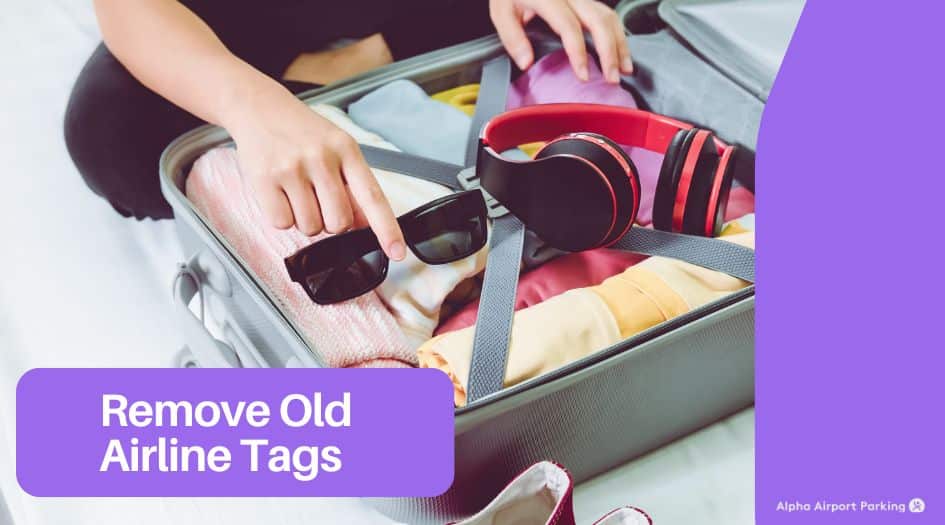Everyone getting on a flight can get anxious, up to some extent, when checking their luggage with an airline. We’ve all heard stories of people’s bags ending up on a different flight or getting lost—or some of you may have experienced those hassles first-hand. Nothing ruins a holiday better than being the only person left waiting on the baggage carousels, with no more bags in sight.
In this blog, we’ll be laying out some tips to help ease your mind during your flight, knowing that your luggage has a better chance of ending up where it’s supposed to be.
1. Remove Old Airline Tags

Retaining outdated airline tags on your luggage can significantly increase the risk of baggage mishandling. These remnants from previous journeys can confuse both human baggage handlers and automated sorting systems, potentially diverting your luggage to unintended destinations. While some travellers may hold sentimental value in these travel mementos, the potential consequences of baggage misdirection, including delays and even loss, outweigh any sentimental attachment.
To mitigate this risk and ensure smooth baggage transportation, consider the following:
- Smart Tag Technology: Invest in smart tags equipped with tracking chips and unique identifying codes. These innovative devices allow airline personnel to easily locate and track your luggage, minimising the risk of baggage mishandling and facilitating rapid retrieval in the event of any unforeseen circumstances.
- Embrace Removable Alternatives: Alternatively, utilise removable luggage tags that can be easily replaced after each trip. This practice ensures accurate routing and minimizes the risk of baggage misdirection by eliminating the potential for confusion caused by outdated information.
Check-In Early

Checking in well in advance of your flight is crucial for minimizing the risk of baggage delays and mishandling. By allowing ample time for airline personnel to process your luggage, you contribute to a more efficient and streamlined check-in process. This proactive approach minimizes the risk of last-minute rushes that can increase the likelihood of human error and potential baggage misdirection.
- Recommended Timeframes: Aim to check in at least 2-3 hours before your scheduled departure, especially during peak travel seasons or at larger airports where longer processing times are common.
- Airline-Specific Guidelines: Refer to your airline’s specific check-in recommendations for the most accurate and up-to-date information, as these may vary depending on the airline, flight route, and time of year.
Place a Copy of Your Itinerary Inside Your Bags

Airport staff usually open missing bags to look for contact information. Put them where they’re the first thing airline personnel see when they inspect your missing bag.
For optimal luggage retrieval, pack an itinerary and contact information as follows:
- Create a comprehensive itinerary: Include your full name, contact number, email address, hotel address (if applicable), and emergency contact information.
- Securely store the itinerary: Place this information within a waterproof and easily accessible pocket within your checked luggage. Consider a small, clear plastic bag or a designated pocket on the inside of the luggage.
- Prioritize visibility: Ensure the itinerary is the first thing airline personnel see when inspecting your bag. This may involve placing it on top of your belongings or in a clearly visible location within the luggage.
- Include your phone number on the itinerary: This allows airline staff to quickly contact you if your luggage is lost or delayed.
By following these steps, you significantly increase the chances of your luggage being returned to you promptly.
Take Photos of Your Luggage

As with every missing items situation, photos can go a long way. Sending clear photographs of your luggage with your claim form can save airline personnel plenty of time to locate your lost belongings. It makes them easier to identify your bags and send them back to you.
Document your luggage thoroughly with photographs:
- Capture multiple angles: Photograph your luggage from various angles, including front, back, sides, top, and bottom.
- Focus on unique features: Capture any distinctive markings, scratches, tags, or damage to your luggage. This could include scuffs, faded colours, broken wheels, or any other identifying characteristics.
Create both digital and physical copies:
- Digital copies: Store photos securely in cloud storage (e.g., Google Photos, iCloud) for easy access.
- Physical copies: Print a copy of the photographs and keep them with your travel documents (passport, tickets, etc.).
Benefits of documenting your luggage with photographs:
- Aids in identification: Clear photographs assist airline personnel in quickly and accurately identifying your luggage among others.
- Expedites the retrieval process: By providing visual evidence, you streamline the identification process for airline staff, potentially leading to faster retrieval of your lost luggage.
- Strengthens your claim: When filing a claim for lost luggage, photographs serve as valuable evidence, supporting your description of the missing item.
Remember:
- Take photos of your luggage before each trip to have an up-to-date record.
- If any damage occurs to your luggage during travel, document it with photos immediately.
Make a List of What’s Inside

There might be instances where airline personnel might ask you for some kind of proof of ownership before they hand you over a lost bag. Having a list with you will make the process of proving that you own the bag much more manageable. This practice will save you and the airport staff a lot of time and effort.
Create a detailed inventory of your checked luggage:
- List all items: Compile a comprehensive list of all items packed in your checked luggage.
- Include identifying information: For each item, include:
-
- Brand name: If applicable
-
- Model number/serial number: If available
-
- Color:
-
- Approximate value:
-
-
- Any unique identifying features: (e.g., scratches, engravings, etc.)
-
- Consider photos: Include photos of valuable items or those with unique characteristics.
Benefits of a detailed inventory:
- Facilitates claims processing: In the event of lost or damaged luggage, this inventory serves as crucial documentation when filing a claim with the airline or your insurance company. It provides detailed evidence of the contents of your luggage and their value.
- Streamlines baggage retrieval: Airline personnel may request proof of ownership before returning lost luggage. A detailed inventory helps you quickly and easily demonstrate ownership of the items within the bag.
- Reduces disputes: A well-documented inventory minimizes potential disputes with the airline regarding the contents and value of your lost luggage.
Tips for creating an inventory:
- Create a digital copy: Store the inventory electronically (e.g., in a spreadsheet, note-taking app, or cloud storage) for easy access.
- Consider printing a copy: Keep a printed copy of the inventory with your travel documents for quick reference.
- Update the inventory before each trip: Ensure your inventory reflects the current contents of your luggage.
Use a Decorative Strap or Tag

This visual aid will help separate your bag from every other black suitcase in the baggage claim area. Making your bags easily recognisable will eliminate the chance of someone else picking them up by mistake.
Enhance Luggage Visibility: Stand Out from the Crowd
To ensure easy identification and prevent accidental misidentification, employ unique visual identifiers for your luggage:
- Utilise distinctive features:
-
- Colourful luggage straps: Add brightly coloured straps or belts to your luggage handles.
-
- Vibrant ribbons: Tie vibrant ribbons or scarves around the handles or zippers.
-
- Unique luggage covers: Invest in eye-catching luggage covers with bold patterns or colors.
-
-
- Distinctive luggage tags: Use brightly coloured or uniquely shaped luggage tags.
-
Benefits:
- Easy identification: These visual cues make your luggage easily distinguishable from others on the baggage carousel.
- Prevents accidental misidentification: By making your luggage stand out, you minimize the risk of others mistakenly taking it.
- Reduces confusion at baggage claim: In a sea of similar-looking luggage, distinctive features help you quickly spot your bags.
Remember:
- Choose identifiers that reflect your personal style and preferences.
- Consider using a combination of different identifiers to further enhance visibility.
- Ensure your identifiers are securely attached to your luggage to prevent them from being lost or damaged.
Consider Getting Travel Insurance

Some policies can offer protection in the event that you lose your luggage. If you’re willing to pay an extra fee for your peace of mind, you can inform the check-in counter that you would like to have your luggage insured. This protection will serve as your safety net in the unfortunate event that your luggage becomes untraceable.
Consider purchasing travel insurance that includes comprehensive luggage coverage. This valuable investment offers financial protection in the event of lost, stolen, or damaged luggage during your travels.
Evaluate Coverage Options Carefully:
- Research different policies: Explore various travel insurance providers and compare their luggage coverage options.
- Assess coverage limits: Determine the maximum amount of reimbursement for lost or damaged luggage.
- Understand deductibles: Familiarise yourself with any deductibles applicable to luggage claims.
- Review claim procedures: Understand the process for filing a claim in case of luggage loss or damage.
Benefits of Travel Insurance with Luggage Coverage:
- Financial protection: Reimbursement for lost, stolen, or damaged luggage helps minimise financial losses and allows you to replace essential items.
- Peace of mind: Knowing you have insurance coverage for luggage-related incidents can reduce stress and anxiety during your travels.
- Coverage for unexpected events: Travel insurance protects against unforeseen circumstances, such as flight delays, medical emergencies, and natural disasters, which may indirectly impact your luggage.
Note:
- Some travel insurance policies may offer specific luggage coverage options as an add-on to basic travel insurance.
- It’s crucial to carefully read the policy terms and conditions before purchasing travel insurance to ensure you understand the coverage limits, exclusions, and claim procedures.
Ship Your Bags

This unorthodox way to avoid lost luggage is to have them shipped instead of flown with you. This method can actually save you some cash, especially if you’re flying with overweight or oversized bags. The charges for extra-dimensional charges can surpass shipping charges.
Sure, it may take a bit longer to arrive, but if you plan your trip well, you’ll be receiving your bags in your hotel just in time for that special occasion.
For travellers facing significant airline baggage fees, especially for oversized or overweight luggage, shipping your luggage directly to your destination can be a viable and potentially cost-effective alternative.
Key Considerations:
- Cost Analysis:
- Calculate airline baggage fees: Determine the total cost of checking your luggage, including potential overweight or oversized baggage fees.
- Compare shipping costs: Obtain quotes from reputable shipping companies, factoring in factors like weight, dimensions, delivery time, and insurance.
Delivery Time:
- Shipping timelines: Assess the estimated delivery time for your luggage to reach your destination.
- Trip itinerary: Ensure the shipping timeline aligns with your travel dates, allowing sufficient time for delivery before your planned activities.
Risk Assessment:
- Potential for damage: Evaluate the potential for damage during shipping.
- Insurance options: Explore insurance options offered by the shipping company to protect your belongings in case of damage or loss.
Benefits of Shipping Luggage:
- Cost savings: Potentially significant cost savings compared to expensive airline baggage fees.
- Convenience: Avoid the hassle of checking bags at the airport and navigating baggage claims.
- Reduced stress: Travel lighter and more comfortably without the burden of heavy or bulky luggage.
Important Considerations:
- Secure packaging: Ensure your luggage is securely packaged to withstand the rigours of shipping. Utilise sturdy boxes or luggage covers and use appropriate packing materials.
- Choose a reputable shipping company: Select a reliable shipping company with a proven track record of safe and timely delivery.
- Plan: Allow sufficient time for shipping to ensure your luggage arrives at your destination on time.
No Valuables

Valuable items like cash, identification and medication should always beinn your carry-on bag. Retrieving lost luggage can take some time, from hours to days. So, you don’t want to risk losing any essential belongings by placing them at your check-in.
Don’t Overload

Learning that you won’t be able to take all of your stuff with you while you’re pressed for time can be a nightmare. You’d most likely be left with no choice but to leave them at the airport.
An easy fix is to bring your vehicle instead of taking a cab. This way, you can leave your excess stuff in your car, and you can leave your car in a secure airport parking facility.
Alpha Airport Parking is the most affordable yet most secure car park option in Brisbane and the Gold Coast.
We offer both undercover and outdoor parking options and free shuttles to ferry you between your car and terminal. Get in touch with us today!





243 Comments
Comments are closed.